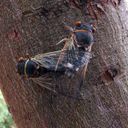Cicadinae
Cicadinae
Classification
- Phylum: Arthropoda
- Subphylum: Hexapoda
- Class: Insecta
- Order: Hemiptera
- Suborder: Auchenorrhyncha
- Infraorder: Cicadomorpha
- Superfamily: Cicadoidea
- Family: Cicadidae
- Subfamily: Cicadinae
Pronunciation
How to pronounce Cicadinae: /sɪˈkeɪdɪniː/
These audio files are automatically generated. While they are not always 100% accurate, they are a good starting point.
Images






Summary
Cicadinae is a diverse subfamily of cicadas known for their robust bodies and vibrant colors. They are primarily sap-feeders with a unique life cycle, and they play an important ecological role while also holding cultural significance in various societies.
Physical Characteristics
Robust, translucent bodies with gaudy colors; generally lack the opaque wing markings typical of some related subfamilies.
Identification Tips
Identify by body shape, coloration, and wing structure; absence of butterfly-like opaque markings is a key feature.
Habitat
Found in a variety of habitats, often in areas with abundant vegetation, such as forests, gardens, and shrublands.
Distribution
Widely distributed in temperate and tropical regions around the world.
Diet
Adult cicadas primarily feed on the sap of trees and shrubs by inserting their proboscis into plant stems.
Life Cycle
The life cycle includes a long nymph stage spent underground followed by a short adult stage; emergence varies by species.
Reproduction
Reproduction involves males calling to attract females; females lay eggs in slits cut into tree bark.
Predators
Common predators include birds, spiders, and various predatory insects.
Ecosystem Role
Play a role in nutrient cycling through their feeding habits and serve as prey for numerous animals.
Economic Impact
Some cicadas may cause damage to trees during the egg-laying process; however, they can also benefit ecosystems as pollinators.
Cultural Significance
Cicadas have cultural significance in various societies, often symbolizing rebirth and immortality due to their periodic life cycle.
Collecting Methods
- Light trapping
- Netting
- Listening for calls
Preservation Methods
- Ethanol preservation
- Drying specimens
Evolution
Morphological and molecular analyses have led to revisions of genera within this subfamily since 2010.
Misconceptions
Often mistakenly thought to be harmful to humans; however, cicadas do not bite or sting.
Tags
- Cicadas
- Cicadinae
- Insects
- Entomology